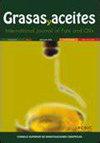姜黄素在不同不饱和度食用油中的动力学和热力学参数
IF 1.1
4区 农林科学
Q4 CHEMISTRY, APPLIED
引用次数: 0
摘要
评估了姜黄素(0.02%-0.1%)在橄榄油、芝麻油和红花油中在 373、383 和 393 K 下的抗氧化活性,其结果与生育酚(0.1%)和 BHT(0.02%)的效果形成对比,从而比较评估了姜黄素的抑制功能。测定了橄榄油(82.94 kJ-mol-1)、芝麻油(77.39 kJ-mol-1)和红花油(74.42 kJ-mol-1)的氧化活化能。添加姜黄素(0.1%)后,橄榄油、红花油和芝麻油的活化能分别提高了 26.26%、26.64% 和 38.81%。根据吉布斯自由能,与其他两种抗氧化剂(生育酚(1.43%)和 BHT(1.39%))的作用相比,姜黄素在 373 K 的橄榄油中的作用更有效(增长系数:1.52%)。姜黄素在多不饱和度较高的油中的效率较低,原因是这些油中的氢供体机制和自由基形成率不成正比。本文章由计算机程序翻译,如有差异,请以英文原文为准。
Kinetic and thermodynamic parameters of curcumin in edible oils with different degrees of unsaturation
The antioxidant activity of curcumin (0.02-0.1%) was evaluated in olive, sesame, and safflower oils at 373, 383, and 393 K. The results were examined in contrast to the effects of tocopherol (0.1%) and BHT (0.02%), so that the inhibitory function of curcumin was evaluated comparatively. The activation energy of oxidation was determined for olive (82.94 kJ·mol-1), sesame (77.39 kJ·mol-1) and safflower oils (74.42 kJ·mol-1). Adding curcumin (0.1%) enhanced the activation energy by 26.26, 26.64, and 38.81% in the case of olive, safflower, and sesame oils, respectively. Based on Gibbs free energy, curcumin functioned more effectively in olive oil at 373 K (growth coefficient: 1.52%), compared to the action of the other two antioxidants, namely tocopherol (1.43%) and BHT (1.39%). The efficiency of curcumin was lower in oils which had a higher degree of polyunsaturation due to the disproportionation of the hydrogen-donating mechanism and the rate of free-radical formation in these oils.
求助全文
通过发布文献求助,成功后即可免费获取论文全文。
去求助
来源期刊

Grasas y Aceites
工程技术-食品科技
CiteScore
2.50
自引率
0.00%
发文量
50
审稿时长
3 months
期刊介绍:
Grasas y Aceites is a peer-reviewed journal devoted to the publication of original articles concerning the broad field of lipids, especially edible fats and oils from different origins, including non acyl lipids from microbial origin relevant to the food industry. It publishes full research articles, research notes, reviews as well as information on references, patents, and books.
Grasas y Aceites publishes original articles on basic or practical research, as well as review articles on lipid related topics in food science and technology, biology, (bio)chemistry, medical science, nutrition, (bio)technology, processing and engineering. Topics at the interface of basic research and applications are encouraged. Manuscripts related to by-products from the oil industry and the handling and treatment of the wastewaters are also welcomed.
Topics of special interest to Grasas y Aceites are:
-Lipid analysis, including sensory analysis
-Oleochemistry, including lipase modified lipids
-Biochemistry and molecular biology of lipids, including genetically modified oil crops and micro-organisms
-Lipids in health and disease, including functional foods and clinical studies
-Technical aspects of oil extraction and refining
-Processing and storage of oleaginous fruit, especially olive pickling
-Agricultural practices in oil crops, when affecting oil yield or quality
 求助内容:
求助内容: 应助结果提醒方式:
应助结果提醒方式:


